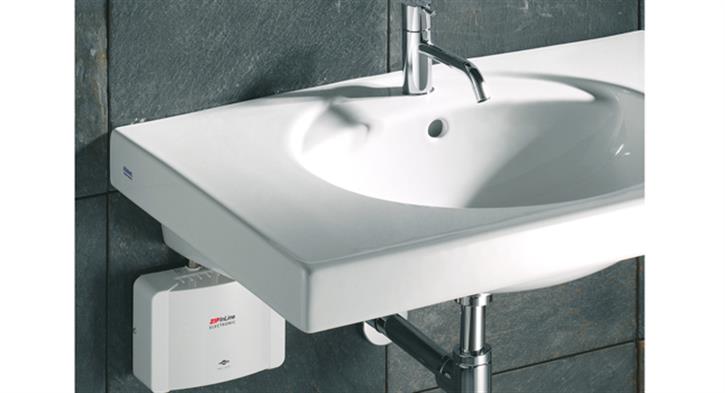

Heating water at point-of-use can make sense when looking for efficient solutions for shared or communal buildings, says Paul Colebrook. Here, he explains some of the benefits of installing instantaneous water heaters.
Centralised heating systems are commonly installed in domestic and commercial properties, but they may not always provide the most practical and energy efficient solution. Such concerns are paramount when it comes to meeting the hot water requirements of medium- to large-sized businesses, which may occupy premises with several storeys, or have significant extensions to accommodate employees, such as in schools or hospitals.
In situations where hot water is required over several floors for hand washing or showering, centralised systems can struggle to deliver water quickly and efficiently to more remote points of use. When providing multiple hand-washing, drinking, bathroom or kitchen facilities, the effective heating, safe storage and hygienic delivery of hot water takes on even greater importance.
When upgrading a building or assessing where savings can be made, it may seem simpler to work with a traditional system, particularly if one is already in place. Yet, as energy prices continue to increase, the extensive pipework and distance pre-heated water may need to travel before use can result in inefficiencies, with heat being lost along the length of flow and return pipework.
The potential for water wastage is another cause for concern. Where extended lengths of pipework have been installed, litres of water may have to be drawn-off before hot water is available through a tap at the point-of-use. With several draw offs required each day, a centralised system may therefore prove financially and environmentally costly to run.
Efficiency increase
Stand-alone, point-of-use electric water heaters, can offer a host of energy-efficiency benefits and the safe delivery of hot water, especially where the main source of hot water in a building is located remotely from the main draw-off points. In fact, where instantaneous water heaters have been installed, the savings can amount to around 23% when compared to stored hot water systems.
Some instantaneous water heaters, such as those manufactured by Zip, have bare-wire heating elements, which offer fast heat-up times and high efficiency, as the heating element is positioned directly in the water flow-path.
The size and mass of traditional elements and heat exchangers means energy is absorbed before the water can be delivered at a useable temperature, and is allowed to dissipate after use. Bare wire technology can help prevent such issues, as water is heated exactly where needed. This not only reduces heat loss, but also removes the need for unsightly pipework, particularly in older buildings. For phased refurbishments that opt for such heaters, there is the extra advantage of being able to ‘add as you go’.
When it comes to hand washing, the water temperature can also be controlled without the need for thermostatic blending valves. With the water heated where and when needed, the risk of legionella is reduced, which is particularly helpful in hospitals, for example.
Manufacturers now offer discreet instantaneous units, compact enough to sit underneath a basin and out of view. They can be linked by short flexible hose connections to traditional taps, which may help alleviate the worries about vandalism sometimes associated with over-sink hand-wash units, as well as offering a tidy and attractive solution with an unlimited choice of taps.
Monitoring capabilities
There are now units available that offer the ability to continually monitor and adjust the power required to maintain the set temperature, compensating for variations in supply pressure or temperature. However, it is worth noting that certain models can require an electrical supply sufficient for ratings of between 4kw to 12kw and, in some instances, three-phase supply.
When selecting a model, installers should always opt for products that have VDE approval to meet the appropriate safety directives.
With such a variety of technologically advanced instantaneous water heating options available, installers can easily avoid fitting lengthy pipe runs to serve remote locations in domestic or commercial settings. It is therefore no surprise that demand for these types of units is on the increase and expected to continue, given the tangible efficiency benefits they can offer.
Paul Colebrook is sales director at Zip Heaters UK
If you'd like to keep up-to-date with the latest developments in the heating and plumbing industry, why not subscribe to our weekly newsletters? Just click the button below and you can ensure all the latest industry news and new product information lands in your inbox every week.